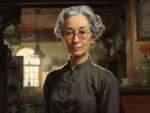“Wise Blood” is a novel written by Flannery O’Connor. It was published in 1952 and is O’Connor’s first novel. It narrates the story of Hazel Motes, a young man in the rural South who embarks on a journey of spiritual quest and struggles with issues of religion, morality, and belief. The novel is noted for its dark humor, grotesque elements, and deep exploration of themes like redemption and the complexities of human nature, which are characteristic of O’Connor’s literary style.
Plot Summary of “Wise Blood”
 In Flannery O’Connor’s “Wise Blood,” the young war veteran Hazel Motes comes back to the southern United States, finding his home and family disappeared. Bitter and disheartened, he rejects his Christian upbringing and chooses a path of nihilism and sin.
In Flannery O’Connor’s “Wise Blood,” the young war veteran Hazel Motes comes back to the southern United States, finding his home and family disappeared. Bitter and disheartened, he rejects his Christian upbringing and chooses a path of nihilism and sin.
As he navigates the corrupt city, he meets a cast of grotesque individuals, including the blind street preacher Asa Hawks and his morally ambiguous daughter, Sabbath Lily. Motes becomes fixated on exposing Hawks as a fraud, convinced of his deceit.
Rejecting traditional religion fiercely, Motes founds the “Church Without Christ,” a movement embracing nihilism. Even with his outspoken criticism of established beliefs, his actions betray a deep internal conflict with the religious principles instilled in him since childhood.
This battle within himself spirals into a tragic journey of self-destruction. To resemble Hawks, whom he wrongly believed to have blinded himself as a form of atonement, Motes blinds himself with lime. He surrounds his body with barbed wire, continuously punishing himself for his perceived sins.
Motes meets a tragic end, leaving readers with a portrait of a man haunted by the very beliefs he tried to abandon. His demise signifies the futile nature of his revolt and the inescapable grip of his origins. O’Connor infuses the story with dark humor, religious symbolism, and remarkable character development, presenting a unique spin on the Southern Gothic genre.
Study Guide
Flannery O’Connor
 Flannery O’Connor was born on March 25, 1925, in Savannah, Georgia. She is renowned for her contributions to the Southern Gothic literary tradition, which combines the grotesque and the spiritual in a style that explores the complexities of the human condition. O’Connor was a devout Catholic, and her faith significantly influenced her works. She attended the University of Iowa Writers’ Workshop. Sadly, her writing career was cut short when she died of lupus at age 39 on August 3, 1964. Despite her short life, O’Connor left a lasting legacy with her darkly comic and profoundly moral tales.
Flannery O’Connor was born on March 25, 1925, in Savannah, Georgia. She is renowned for her contributions to the Southern Gothic literary tradition, which combines the grotesque and the spiritual in a style that explores the complexities of the human condition. O’Connor was a devout Catholic, and her faith significantly influenced her works. She attended the University of Iowa Writers’ Workshop. Sadly, her writing career was cut short when she died of lupus at age 39 on August 3, 1964. Despite her short life, O’Connor left a lasting legacy with her darkly comic and profoundly moral tales.
Historical and Cultural Context of “Wise Blood”
It was published in 1952, a period marked by a significant transition and turmoil in the United States. The country was grappling with the aftermath of World War II, experiencing a religious revival, and entering the early stages of the Civil Rights Movement. The South, where O’Connor was both raised and chose to remain, was a region steeped in tradition and in the beginning stages of immense societal change.
 The novel reflects the existential crisis that many experienced during this time, as traditional religious beliefs were increasingly questioned. It portrays a world where faith is in conflict with secularism, depicted through the grotesque and morally ambiguous characters and settings that are hallmarks of the Southern Gothic genre.
The novel reflects the existential crisis that many experienced during this time, as traditional religious beliefs were increasingly questioned. It portrays a world where faith is in conflict with secularism, depicted through the grotesque and morally ambiguous characters and settings that are hallmarks of the Southern Gothic genre.
O’Connor’s narrative intricately combines elements of humor, religion, and moral complexity, representing a profound exploration of faith and redemption in a changing world. Through Hazel Motes, O’Connor explores the notion of spiritual struggle and the human tendency to resist grace, a theme that is echoed in much of her work. The raw, vivid imagery and the profoundly flawed characters offer a glimpse into a society grappling with modernity while being anchored in deep-rooted traditions.
Characters Breakdown
Hazel Motes
Hazel Motes is the central character in “Wise Blood”. A young man of about 22 years, he is a discharged soldier who struggles with his faith, constantly swinging between the realms of sin and redemption. He has a deep-seated anger and an urge to rebel against conventional Christian beliefs, which leads him to create his own “Church Without Christ”. Hazel is depicted as a complex individual, grappling with his spirituality in a world that seems to have moved away from traditional religious moorings. His journey throughout the novel is one of self-discovery and, ultimately, self-destruction, marked by a violent rejection of organized religion and an embrace of radical nihilism.
Enoch Emery
Enoch Emery, a young man around 18 years old, works at the city park and has a peculiar obsession with the concept of “wise blood”, which he believes grants him insights into the deeper truths of existence. Enoch, desperate for approval and belonging, often finds himself influenced by a primal, almost animalistic intuition. His actions, driven by an unfulfilled desire for recognition and validation, showcases the stark contrast between the sacred and the profane in O’Connor’s narrative landscape.
Sabbath Lily Hawks
Sabbath Lily Hawks, a teenage girl, is a complex character who embodies both innocence and moral decay. She is the daughter of Asa Hawks, a blind preacher, though her father’s blindness is later revealed to be a deceit. Sabbath Lily flaunts her sinful nature openly, providing a counterpoint to Hazel’s struggle with faith. She is attracted to Hazel, offering herself to him without any inhibitions, representing a departure from traditional Christian virtues surrounding purity and femininity.
Asa Hawks
Asa Hawks is a fraudulent preacher who pretends to be blind as a means to exploit the faith of his followers. His character serves as a critique of the hypocrisy and moral corruption that can sometimes be found in organized religion. Despite his deceitful nature, he is a catalyst in Hazel’s spiritual journey, representing the disillusionment and moral decay that O’Connor perceived in the religious landscape of her time.
Mrs. Flood
Mrs. Flood is the owner of the boarding house where Hazel Motes stays towards the end of the novel. Initially, her interaction with Hazel is driven by her financial interests and a curiosity about Hazel’s odd behaviors. As the story progresses, she becomes a significant character showcasing compassion and a degree of understanding towards Hazel, even when his actions are incomprehensible to others.
Onnie Jay Holy
Onnie Jay Holy is a character who Hazel encounters during one of his street preaching sessions. He initially pretends to be a convert to Hazel’s “Church Without Christ” but later reveals himself to be a scam artist. He takes Hazel’s ideas and forms his own profit-making venture, twisting Hazel’s already unconventional theology into something even more grotesque and commercialized. His character is a commentary on the exploitation and commercialization of religion.
Themes
“Wise Blood” is a rich tapestry of deep and often provocative themes. Here we delve into the most prominent ones, alongside their textual examples, followed by an exploration of significant symbols and motifs found in the novel.
Religion and Faith
In “Wise Blood”, religion and faith are explored primarily through the character of Hazel Motes. Hazel vehemently rejects conventional religious beliefs, establishing the “Church Without Christ”, where the aim is to liberate individuals from the restrictive doctrines of Christianity. His continuous struggle with faith showcases the crisis of spirituality in the modern world.
Example from the text: Hazel’s proclamation, “I don’t have to run from anything because I don’t believe in anything.”
Redemption and Moral Struggle
Characters in the novel are often seen grappling with their inner demons, seeking redemption in their peculiar ways. Hazel’s self-inflicted suffering towards the end of the novel is a vivid representation of the human quest for atonement and moral struggle.
Example from the text: Hazel blinding himself as a form of self-punishment, showcasing his intense moral struggle and seeking redemption.
The Grotesque and the Absurd
Flannery O’Connor is known for her use of grotesque elements in her narrative, and “Wise Blood” is no exception. The novel is rife with bizarre characters and absurd situations, which mirror the sense of displacement and moral decay in the modern society.
Example from the text: The character of Enoch Emery, who is obsessed with a shrunken man exhibit, showcasing the absurdity and grotesque elements in the society depicted in the novel.
Symbols and Motifs
The Rat-colored Car
The car Hazel purchases serves as a symbol of his rebellion against conventional religion. The dilapidated condition of the car reflects Hazel’s internal chaos and his self-destructive path.
The New Jesus
Enoch’s obsession with the shrunken man, which he eventually steals, embodies the distorted perception of religious icons in the modern world, symbolizing a ‘New Jesus’ that is commercialized and stripped of its sacredness.
Through the in-depth exploration of these themes and symbols, “Wise Blood” presents a scathing critique of the modern society’s relationship with religion and morality, delivered through the lens of grotesque realism and absurdity.
The Concept of “Wise Blood”
 The concept of “wise blood” serves as a symbolic thread that connects the underlying themes of faith, redemption, and the grotesque. It is presented as an innate, almost visceral knowledge or intuition that guides the characters in their moral and spiritual journeys.
The concept of “wise blood” serves as a symbolic thread that connects the underlying themes of faith, redemption, and the grotesque. It is presented as an innate, almost visceral knowledge or intuition that guides the characters in their moral and spiritual journeys.
Hazel Motes, the central character, is significantly influenced by this concept. His grandfather, a preacher, believed in the idea that wisdom and moral guidance are embedded in one’s blood, an inheritance that cannot be easily discarded. This becomes evident in Hazel’s relentless struggle against his inherent religious inclinations, despite his fervent attempts to reject traditional religious beliefs.
The notion of “wise blood” seems to propose that certain individuals possess a deep-seated moral compass, a natural pull towards spiritual matters, even when they try to renounce it. Hazel’s “wise blood” continually draws him back to a path of faith and redemption, leading him to a brutal self-punishment in an attempt to find salvation.
The concept serves as a testament to the complexity of human nature and spirituality, highlighting the incessant battle between personal beliefs and inherited convictions. It paints a grim picture of the human condition, one fraught with internal conflict and the inherent quest for understanding and redemption.
My Review
“Wise Blood” is not just a novel; it’s a revolution. Its raw, harrowing realism presents a scathing critique of traditional religious narratives, offering a perspective more authentic and poignant than even the Bible. This is a daring claim, but Flannery O’Connor’s exploration of faith and morality seems to surpass ancient religious texts in depth and honesty. Hazel Motes, the protagonist, emerges as a modern prophet in a world disillusioned with sugar-coated spirituality. His journey showcases a vivid yet harsh depiction of the authentic human condition.
Moreover, “Wise Blood” stands as a modern bible. It is a beacon in the murky waters of spirituality where sacred and profane lines blur. It’s an unfiltered lens into human spirituality’s chaotic spectrum, urging readers to navigate it with courage and nuance. This piece serves as a literary sanctuary offering not just artistic excellence but a nuanced pathway into human belief and morality. It is a refreshing and unsettling guide for understanding the depths of human faith, emerging as a new age gospel.
What do you think? Welcome to the comments section!





Comments